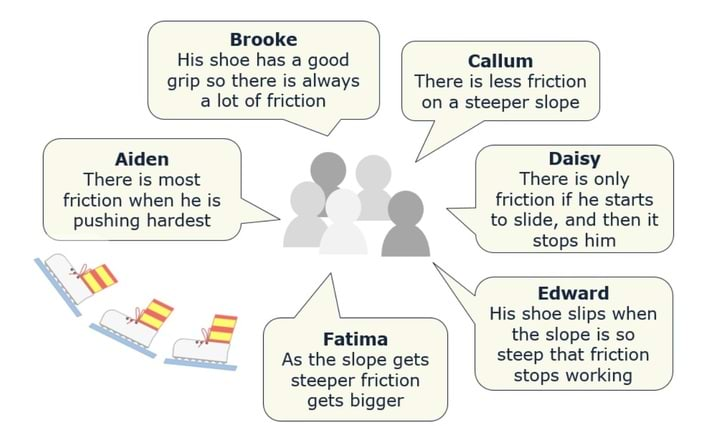Learning focus: | Friction is a force generated by an interaction between two surfaces, and which acts to resist movement between them. |
Observable learning outcome: | Explain how friction, generated by the interaction between two objects, can stop them from moving. |
Activity type: | Response, talking heads |
Key words: | Friction, force, rough |
Friction is the force generated by an interaction between two objects. This is different to most forces which cause the interaction (Hart, 2002). This perhaps led to the finding from a study of thirty-eight 12-16 year olds, that fewer than half of students identify friction as a force (Stead and Osborne, 1980).
A later study of forty-seven secondary students, by Stead and Osborne (1981), showed that some students think that:
- friction depends on movement (seventeen students)
- friction only happens between solids (twelve students)
- friction is the same thing as reaction (nine students)
In Stead and Osborne’s 1980 study they found that half of 13-year old students also thought of friction as rubbing. But friction is also acting between objects that are not moving. Text books for 11-14 year old students often talk about shoes or tyres having a good grip. The implication is that the shoe or tyre ‘has a lot of friction’, which It does not. Rather it is good at generating friction when it is pushed along a surface, and often the friction it generates prevents it from moving.
In a study of 32 Canadian students aged 6 – 14, Erikson and Hobbs (1978) found that when thinking about two forces acting on the same object, students appeared to think of the forces as being engaged in a struggle, with the bigger force dominating the smaller one. This may lead some students to think that friction disappears when an object starts moving.
This activity challenges students to think about their ideas about friction is generated by an interaction between two objects, when an external force is applied, or when they are moving relative to each other.
Students should complete this activity in pairs or small groups, and the focus should be on the discussions. The statements are also provided as cut-out cards for students to physically organise. Students should work together to follow the instructions on either the worksheet or the PowerPoint. Giving each group one worksheet to complete between them is helpful for encouraging discussion, but each member should be able to report back to the class. Listening in to the conversations of each group will often give you insights into how your students are thinking.
If there is disagreement when you take feedback, a good way to progress might be through structured class discussion. Ask one student to explain why they gave the answer they did; ask another student to explain why they agree with them; ask another to explain why they disagree, and so on. This sort of discussion gives students the opportunity to explore their thinking and for you to really understand their learning needs.
Differentiation
The quality of the discussions can be improved with a careful selection of groups; or by allocating specific roles to students in the each group. For example, you may choose to select a student with strong prior knowledge as a scribe, and forbid them from contributing any of their own answers. They may question the others and only write down what they have been told. This strategy encourages contributions from more members of each group.
Aiden and Fatima are correct. As the slope gets steeper, the force with which gravity pushes on the teacher’s shoe, in a direction along the slope, increases. This has the same effect as ‘pushing harder’. As the pushing force increases the force of friction also increases because whilst the shoe is not moving these two forces must be balanced.
Edward is wrong because if the shoe slips friction will continue to act. The shoe slips when the force pushing the shoe becomes bigger than the maximum possible friction between the shoe and the slope. The resultant force will cause the shoe to accelerate down the slope.
Brooke is thinking of friction as a property of the two objects instead of as a force generated when they interact.
Callum has wrongly linked his experience of slipping on steeper slopes to there being less friction. Instead there is more force pushing against friction.
Daisy is thinking of friction as caused only by rubbing, when surfaces move in relation to each other.

